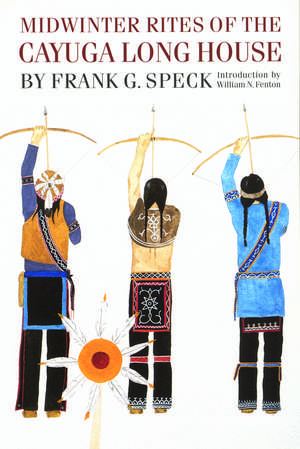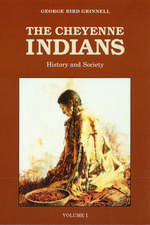Midwinter Rites of the Cayuga Long House
Autor Frank G. Speck Introducere de William N. Fentonen Limba Engleză Paperback – 28 feb 1995
During his last years ethnohistorian Frank G. Speck turned to the study of Iroquois ceremonialism. This 1950 book investigates the religious rites of the Cayuga tribe, one of six in the Iroquois confederation that occupied upstate New York until the American Revolution. In the 1930s and the 1940s Frank Speck observed the Midwinter Ceremony, the Cayuga thanksgiving for the blessings of life and health, performed in long houses on the Six Nations Reserve in Ontario.
Collaborating with Alexander General (Deskáheh), the noted Cayuga chief, Speck describes vividly the rites and dances giving thanks to all spiritual entities. Of special interest are the medicine societies that not only prescribed herbs but used powerfully evocative masks in treating the underlying causes of sickness.
In a new introduction, William N. Fenton discusses Speck’s distinguished career.
| Toate formatele și edițiile | Preț | Express |
|---|---|---|
| Paperback (1) | 104.35 lei 3-5 săpt. | |
| BISON BOOKS – 28 feb 1995 | 104.35 lei 3-5 săpt. | |
| Hardback (1) | 553.62 lei 6-8 săpt. | |
| MT – University of Pennsylvania Press – 24 ian 1950 | 553.62 lei 6-8 săpt. |
Preț: 104.35 lei
Nou
Puncte Express: 157
Preț estimativ în valută:
19.97€ • 20.85$ • 16.49£
19.97€ • 20.85$ • 16.49£
Carte disponibilă
Livrare economică 25 martie-08 aprilie
Preluare comenzi: 021 569.72.76
Specificații
ISBN-13: 9780803292314
ISBN-10: 0803292317
Pagini: 208
Dimensiuni: 140 x 216 x 28 mm
Greutate: 0.32 kg
Editura: BISON BOOKS
Colecția Bison Books
Locul publicării:United States
ISBN-10: 0803292317
Pagini: 208
Dimensiuni: 140 x 216 x 28 mm
Greutate: 0.32 kg
Editura: BISON BOOKS
Colecția Bison Books
Locul publicării:United States
Notă biografică
William N. Fenton, a Distinguished Professor Emeritus of anthropology, SUNY at Albany, is the author of The False Faces of the Iroquois.
Recenzii
“The charm of [Dr. Speck’s] book is matched only by the quiet dignity and poetic imagery of the Cayuga. Immersing himself in the native scene, the author entered sympathetically into the spirit of their thought. . . . Both the prayers and myths are remarkable for their power and loveliness.”—Canadian Historical Review
“Since Speck’s attitude towards native religion was charged with the highest respect and sympathy, he always was extremely successful in eliciting the cooperation of informants in securing reliable information. . . . Speck’s linguistic gifts also facilitated such inquiries.”—American Anthropologist











